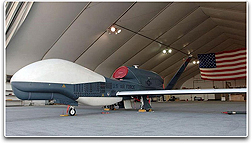The national-flag carrier, with the technological help of a foreign defense firm, will develop and integrate the spy plane's fuselage and other related systems, including a ground-control station and mission equipment package (MEP), in cooperation with the state-run Agency for Defense Development (ADD), said the source.
They will conduct preliminary research and development between 2008 and 2 011 before developing and integrating systems between 2012 and 2016, he said. The proposed UAV will be designed to perform missions as high as 50,000 feet (some 15 kilometers) for more than 24 hours and will have similar specifications to the MQ-1 Predator medium-altitude, long-endurance UAV of the U.S. Air Force, ADD officials said.
011 before developing and integrating systems between 2012 and 2016, he said. The proposed UAV will be designed to perform missions as high as 50,000 feet (some 15 kilometers) for more than 24 hours and will have similar specifications to the MQ-1 Predator medium-altitude, long-endurance UAV of the U.S. Air Force, ADD officials said.
About 450 billion won will be spent to build the surveillance aircraft, they said. “With the successful bidding for the medium-altitude UAV project, Korean Air is expected to get the upper hand in building the nation's unmanned aircraft systems both for civilian and military use down the road,'' the source said, asking not to be named.
Korean Air's successful bidding was attributable to its better aircraft-making and system integration capabilities than those of KAI, said DAPA officials. A 2006 revision of the law governing the designation of defense manufacturers was also a key reason for the airline winning the competition, they said.
Previously, those firms designated by the government as defense manufacturers got preferential treatment in bidding for state arms acquisition or development programs. They were mostly small- and medium-sized firms.
The revision, however, allows any companies, including conglomerates, to vie for such programs as long as they have strong capacity to build the weapons systems concerned. The revised law is to be put into effect at the beginning of next month after a two-year grace period, according to DAPA.
Earlier this year, the Ministry of National Defense hinted that it would push harder for developing an indigenous UAV rather than purchasing the Global Hawk high-flying UAV from the United States.
Senior ministry officials said that's because of not only budget constraints but also the Lee Myung-bak administration's pursuit of cost-effective management of defense assets based on closer cooperation with the U.S. military. Seoul had sought to buy Global Hawks by 2011 to strengthen independent intelligence, surveillance and reconnaissance capabilities for its planned takeover of wartime operational control from the United States in 2012.
The Global Hawk can survey vast areas with near pinpoint accuracy from as high as 65,000 feet for up to 35 straight hours. The per-unit price is $45 million to $60 million. The South Korean military is largely dependent on U.S. intelligence, surveillance and reconnaissance (ISR) capabilities over North Korea.
The U.S. Forces Korea operates several ISR systems, such as U2 reconnaissance and RC-12 surveillance aircraft. The U.S. KH-11 satellite is also a key system to help detect suspected activities in North Korea.
The satellite can detect an on-land object as small as 15 centimeters in length. South Korea's Air Force operates eight Baekdu and Geumgang reconnaissance planes, while the Army flies the domestically built RQ-101 Night Intruder and Israel's Searcher II UAVs with its frontline corps near the heavily fortified border with the North.


















No comments:
Post a Comment